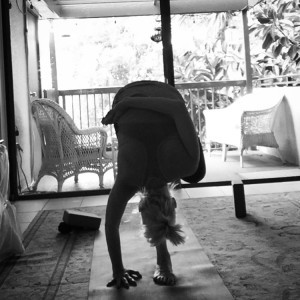Moving Through — And Beyond — Trauma

As I started practicing yoga, huge shifts happened. I’d find myself weeping during practice, especially in forward folds like this. Long-held feelings of shame and the belief that no one liked me were bubbling up to the surface. My teacher said this was my “chitta vrittis” coming up, and that the process would rid me of them.
I wasn’t looking for that, and had I not been living in Qatar– where the gyms held “ladies hours” which left this working lady with no choice but to do this damn yoga class–I doubt I would’ve stuck with it. Practicing forced me to observe these feelings rather than get involved with the storylines, because standing in half lotus while folded over your leg requires a certain amount of concentration on its own. This allowed me to see that I didn’t have to be overwhelmed by my own stories. As has been the case throughout my life, I also believe this was the gods way of giving me some much-needed strength, because it wasn’t long after I began to teach others in Doha that my husband left. Had I not been teaching, maybe I wouldn’t have continued to practice. One thing was clear, consistent practice was the key to overcoming life’s traumas. Though it hasn’t been my only resource.
Practicing a hard core form of yoga enabled me to get calmer in my body, and my mind. This finally enabled me to sit in meditation.
Getting into the above — ardha baddha padmottanasana — requires warmed up hamstrings and shoulders. It comes toward the end of the standing sequence in the primary ashtanga yoga practice. The key to finding stillness in this pose, once I had the strength and flexibility for it, was in engaging my core, from my foot up to my chin. Everything, in and up. Try it, and let me know if that works for you. I have comments shut off on my blog (though it doesn’t look like it, I know, but you can’t comment), so you can hop over to my Facebook page and weigh in on this.
#yogaeverydamnday



